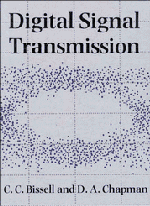Book contents
- Frontmatter
- Contents
- Preface
- 1 Introduction
- PART 1 MODELS
- PART 2 PROCESSES
- PART 3 DIGITAL TRANSMISSION OVER THE PUBLIC SWITCHED TELEPHONE NETWORK
- Appendix A Fourier series and transforms
- Appendix B Convolution
- Appendix C Modelling applications of spreadsheets
- Answers to numerical exercises
- References
- Index
PART 3 - DIGITAL TRANSMISSION OVER THE PUBLIC SWITCHED TELEPHONE NETWORK
Published online by Cambridge University Press: 05 June 2012
- Frontmatter
- Contents
- Preface
- 1 Introduction
- PART 1 MODELS
- PART 2 PROCESSES
- PART 3 DIGITAL TRANSMISSION OVER THE PUBLIC SWITCHED TELEPHONE NETWORK
- Appendix A Fourier series and transforms
- Appendix B Convolution
- Appendix C Modelling applications of spreadsheets
- Answers to numerical exercises
- References
- Index
Summary
So far, this book has been concerned with models and processes which are relevant to a wide variety of telecommunication systems. The linear modelling tools of Part 1, and the digital techniques of coding, modulation and pulse processing discussed in Part 2, are applicable to line telephony, digital microwave links, satellite and mobile systems, and many other fields. In a book this size it is impossible to deal with all areas of modern digital telecommunications. To set the previous material into context, we have chosen therefore to concentrate in this final part on transmission aspects of just one, large-scale, system: the digital public switched telephone system or PSTN. The wide variety of topics with which a modern telecommunications engineer needs to be conversant is reflected particularly here, ranging from the borders of electronics almost to those of software engineering.
Fig. 1.1 of the Introduction showed part of an integrated services digital network (ISDN), in which signals from a variety of sources are transmitted over a universal network. Some of these signals are inherently digital (such as computer data), others are by nature analogue (such as speech input to a telephone handset). In an ISDN they are all transmitted as digital signals with a common format, and their origin is immaterial as far as network management is concerned.
There are currently (1992) few examples of true ISDNs. Nevertheless, in many countries the public switched telephone network is evolving in this direction. Fig. 3 shows part of such a telephone network. The boxes represent exchanges interconnected by numerous trunk routes.
- Type
- Chapter
- Information
- Digital Signal Transmission , pp. 231 - 235Publisher: Cambridge University PressPrint publication year: 1992



